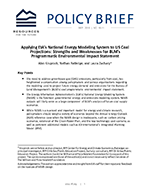Applying EIA’s National Energy Modeling System to US Coal Projections: Strengths and Weaknesses for BLM’s Programmatic Environmental Impact Statement
This brief examines EIA’s National Energy Modeling System with respect to BLM’s federal coal leasing review. We find that BLM should weigh a variety of well-crafted scenarios and other model inputs when preparing its draft environmental impact statement.
Key findings
- The need to address greenhouse gas (GHG) emissions has heightened a conversation among policymakers and various organizations regarding the modeling used to project future energy demand for the Bureau of Land Management’s (BLM’s) federal coal review.
- The Energy Information Administration’s (EIA) National Energy Modeling System (NEMS) is the foremost governmental energy and emissions modeling system. NEMS outputs will likely serve as a large component of BLM’s analysis of future coal supply.
- While NEMS is a nuanced and important model, policymakers should weigh a variety of scenarios beyond the Annual Energy Outlook (AEO) reference case, such as carbon pricing, extension of the Clean Power Plan, and the low technology cost scenario.
- When the NEMS design is inadequate, policymakers should rely on pertinent additional models, such as ICF International’s Integrated Planning Model (IPM).
- A series of reasonably likely scenarios will add pressure to future coal demand. If the United States is to meet its climate goals, further pressure will likely fall on the electricity sector, thus reducing coal generation beyond the 2016 NEMS output.
- To address scenarios that are not modeled by the 2016 AEO, the Department of the Interior and BLM should develop a series of additional model runs that more fully capture foreseeable climate-related policy.
Authors

Nathan Ratledge

Laura Zachary





